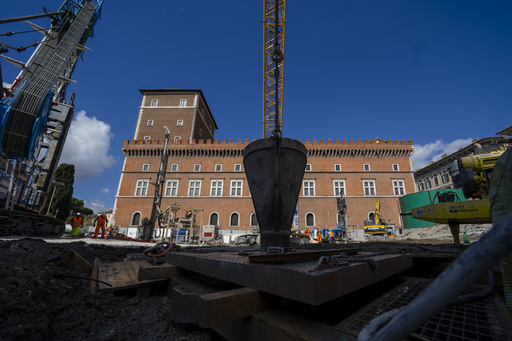ROME (AP) — A long-delayed and complex project to bring a subway line under ancient Roman ruins and through Rome’s historic center has entered a crucial phase, with the digging of an 85-meter (280-foot)) deep retaining wall around the flagship station.
During a tour Thursday of the construction site at Piazza Venezia, chief engineer Andrea Sciotti said work on the nearly 3 billion euro ($3.3 billion) project, considered one of the most complicated of its kind in the world, was likely to be completed by 2034.
The Metro C subway line has been in the works for two decades but has been slowed by bureaucratic and funding delays and, crucially, the archaeological excavations necessary given the underground ruins of Imperial Roman and Medieval civilizations in its way.
When completed, the subway line will run underneath some of the world’s most important cultural heritage sites — the Colosseum, Trajan’s Column and the Basilica of Maxentius, the largest building in the Roman Forum -– as well as some of Rome’s prized Renaissance palazzi, churches and the Vatican.
As a result, Italy’s culture ministry has been involved at every step and will be on hand once the digging begins in earnest on the first 15 meters (50 feet) of the Piazza Venezia station, where the ruins from ancient Rome lie. During that phase, archaeologists will be guiding the excavations, taking objects for study, restoration and eventual placement in a museum within the station itself when it opens, Sciotti said.
“I think I can say it’s unique in the world because we don’t only have the Colosseum and the Basilica of Maxentius, but we have 15-20 meters of hidden archaeological patrimony -– known but hidden,” he told reporters at the site. “This obviously brings problems that must be resolved in the planning and realization phases.”
To underscore the delicacy and uniqueness of the Piazza Venezia hub, Sciotti noted that in the 10 years and 755 million euros ($818 million) it will take to dig and build the station, four other stations will be built along the Metro C line heading out of the center toward the Vatican and beyond.
“Twenty, thirty years ago, it would have been very difficult to do this,” he said. But thanks to new technology, it’s now possible to both dig underneath archaeological sites and protect above-ground patrimony, he said, adding that he has already presented the Metro C project to engineers in Ecuador who are also planning a subway line through Quito’s historic center.
For now, the work is in the preliminary phase of digging the 85-meter (280-foot) -deep retaining wall of reinforced cement around the perimeter of the Piazza Venezia station. A massive hydro mill trench cutter digs rectangular-shaped columns down that are then filled to make a retaining wall to keep water out and secure the site’s perimeter before the actual digging begins.
While Rome already has two main subway lines, including one with a stop at the Colosseum, the Metro C line will penetrate the heart of the historic center and connect it to the Vatican and beyond, providing new options for the Eternal City’s chronically insufficient public transport system.
Once the line reaches Piazza Venezia, the subway tunnels themselves will run at an underground depth of 45 meters (150 feet), to also spare the above-ground historic palazzi and churches from the vibrations that a subway closer to the surface might create.
When opened, the eight-level Piazza Venezia station will provide underground connections to the Vittoriano “wedding cake” monument at the heart of the piazza, the Palazzo Venezia museum on one side and the museum under Hadrian’s Athenaeum, built in 123 A.D., on the other.
Sciotti said it was the work near the Hadrian archaeological site -– with its delicate Trajan’s Column standing upright — that makes him most fearful, even if careful monitoring is underway and crews will use a buffering technique to limit above-ground vibrations that was used in London along the Jubilee tube line.
If anything happens to the Trajan’s Column, “I have my passport ready,” he said, joking.
This website uses cookies so that we can provide you with the best user experience possible. Cookie information is stored in your browser and performs functions such as recognising you when you return to our website and helping our team to understand which sections of the website you find most interesting and useful.
